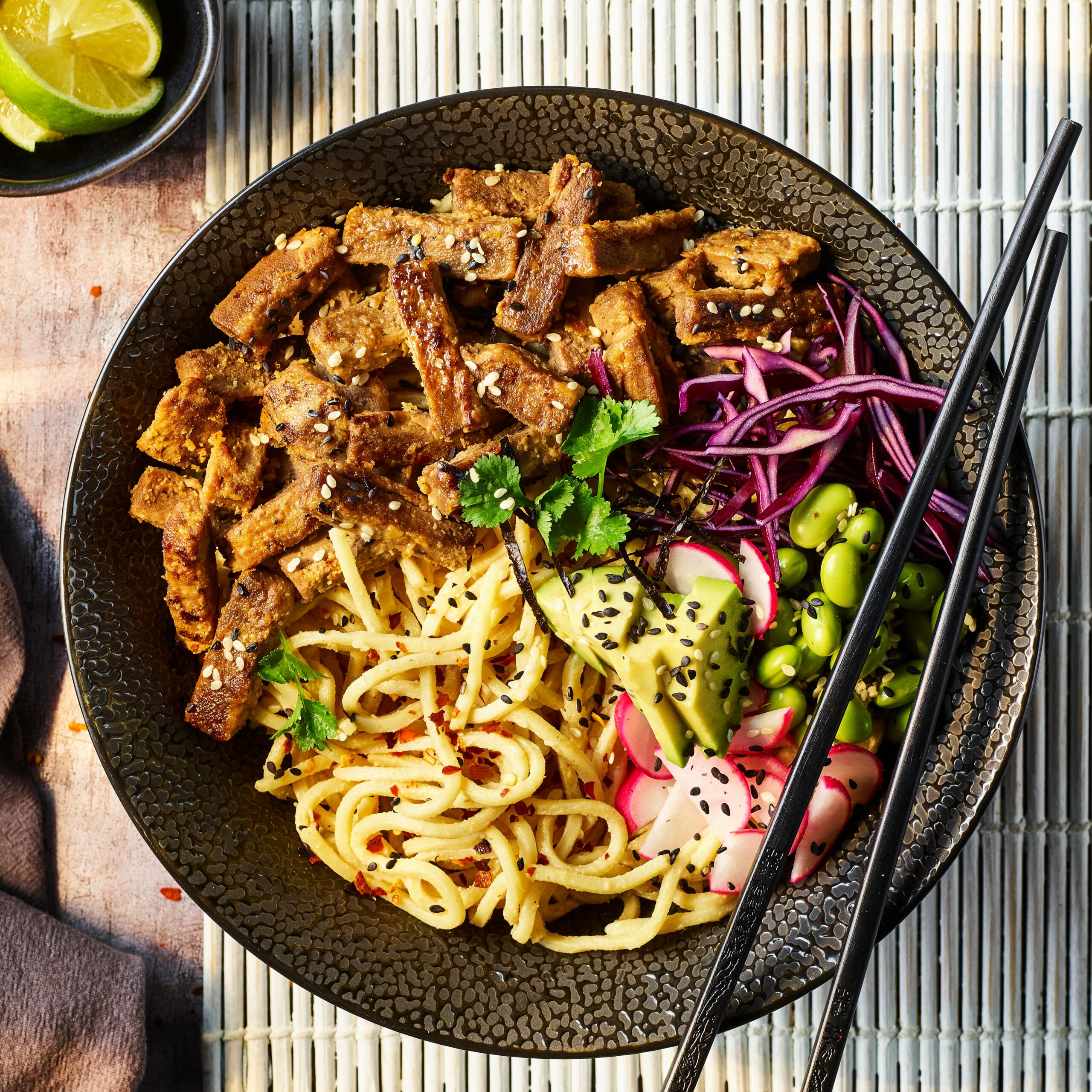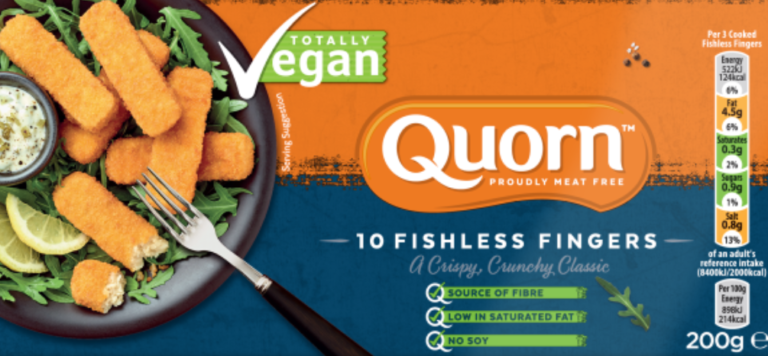
Quorn: Breaking the Mold of Alt Proteins
In the 1960s, global leaders began to sound the alarm about concerns of food insecurity amidst a rapidly growing human population. More than five decades later, that alarm has become deafeningly loud. By 2050, the UN projects that nearly 10 billion people will inhabit the Earth, and conventional methods of agriculture will be woefully insufficient to meet the enormous demand for reliable sources of protein.
Through our Asia Stories of Alternative Protein (ASAP) series, we’ve been highlighting some of the groundbreaking companies and initiatives that are working to fill that gap, including within the plant-based ecosystem and the cutting-edge field of cultivated meat. But today’s featured company, Quorn, has firmly established itself as the undisputed leader of their own category—dubbed biomass fermentation—and now they’re taking their successful model global.
Company Information
| Website | https://www.quorn.com |
| Location | Stokesley, North Yorkshire (U.K.)* |
| Since | 1985** |
| Business Type | Prepackaged food products** |
| Parent Company | Monde Nissin** |
| Staff Size | 800** |
| Ownership Status | Operating subsidiary** |
| Notable recent developments | Provided the filling for the vegan sausage rolls at Gregg’s, the largest bakery chain in the U.K., which sold out nationwide and became an international media sensation |
Data retrieved from LinkedIn* and Pitchbook** on 24 August 2020.
Fungus Among Us
Steve Jobs famously said that “Innovation distinguishes between a leader and a follower.” Quorn’s visionary founder, Lord Rank, was a leader whose innovative work was decades ahead of his time. Back in 1964, Rank began his years-long process of researching thousands of microorganisms to try to find an alternative protein source that could efficiently translate carbohydrates into protein but is also safe, nutritious, and rapidly scalable. Even after settling on the microorganism that best checked all of those boxes—a fungus (or more accurately, a mold) called Fusarium venenatum—it still took another 20 years to develop the commercially scalable product that Quorn has dubbed “mycoprotein.”
Since their debut in the 1980s, Quorn’s mycoprotein products have enjoyed decades of commercial success in the U.K. and across Europe, but over the past several years, they’ve been looking increasingly towards the vast markets to the east.
In 2015, Philippines-based food-industry powerhouse Monde Nissin acquired Quorn to the tune of 550m British pounds (US $838m). At the time, Quorn was already operating in 15 countries but needed help breaking into the Asia-Pacific market in a big way. Meanwhile, Monde Nissin was aiming to diversify their health and sustainability portfolio, creating what Andy Kusumo, Monde Nissin’s Director of Science and Technology, called a win-win.
That strategic pivot is already paying big dividends. Quorn now has a dedicated team based in Singapore, where they also operate a Future Food kitchen lab, and their products are widely available across the Philippines and Thailand. A roll-out into the massive Indonesian market—where other traditional fermented products, like tempeh, have been widely consumed for centuries—is also in the works, and Quorn products can be found at select retailers in Hong Kong, Malaysia, and other key markets. Monde Nissin’s deep knowledge of the local cultural nuances have helped make Quorn’s global reorientation successful, but it also would not have been possible without the staggering versatility that mycoprotein offers.
Billions and Billions Served
Mycoprotein in its raw form looks like chicken flesh, according to Kusumo, but it has a neutral taste, which is why it is the ideal blank canvas to use as a foundation for a nearly unlimited range of products.

As GFI’s first-of-its-kind report on the state of the fermentation sector summarizes, the innovation potential of this space “is still largely untapped. Innovations in fermentation will improve plant-based products and cultivated meat, in turn increasing demand and market opportunity—leading to a virtuous cycle of growth in the alternative protein industry.” The report concludes that “Mycelium, microalgae, microbes, and fermented plant proteins can provide the sensory experiences and full nutritional profiles of animal products but without undesirable substances, such as cholesterol, antibiotics, and hormones. Fermentation’s ability to efficiently produce protein could resolve the global protein deficit.”
Seizing on that opportunity, Quorn produces a wide variety of prepackaged meals that seamlessly replace conventional animal proteins, from chicken and beef to fish and other seafood. Kusumo says that customers in Western markets tend to skew towards the beef alternative products, but in Asia, chicken, pork, and seafood are the big sellers. From vegan breaded fillets to meat-free crispy nuggets, Quorn aims to fill every niche in the market.
One big advantage that the fermentation sector has over other food technologies is that both microbial fermentation as a processing method and ingredients derived from microbial cultures have a long history of use in the food industry. Given this history, well-established regulatory systems to ensure the safety of innovations within this platform are already in place in most jurisdictions.
“It’s all about transparency.”
Kusumo says that Quorn representatives often personally sit down with regulators to share their company history and help food-safety officials understand the science behind their innovative products. If regulators express any concerns, the company’s representatives are quick to point to their decades-long track record of consumer satisfaction in Europe, which has led Quorn to serve more than five billion meals to date.
Let’s Grow Mold Together
Fermentation is an inherently resource-efficient and highly-scalable food category, even in comparison to other alternative proteins. According to Quorn, with just under a gram of Fusarium venenatum, the company can use fermentation to grow more than 1,500 tonnes of mycoprotein. This efficiency also means that the company can afford to sell their products at a very competitive price point. For example, in Southeast Asia, a package of four hot and spicy vegan Quorn burgers can be purchased for 7 Singapore dollars, compared with almost 14 dollars for two frozen plant-based Beyond Burger patties.
Quorn’s proven track record of successful market rollouts—and heavy investment into peer-reviewed scientific research about the nutritional benefits of mycoprotein—has also drawn the attention of many potential partners. While Kusumo was understandably tight-lipped about which companies he and his colleagues have worked with on a B2B partnership, they reportedly include some of the largest brands in the alternative meat space. “They know that we have the experience and have brought the product into the market quite successfully,” Kusumo says. Quorn also works all across the value chain—“downstream, upstream, and in the middle”—and as a result, Monde Nissin’s door is always open to new companies and potential collaborators who want to tap into their deep knowledge of the Asia-Pacific region. Quorn’s manufacturing and logistics operations are intentionally decentralized, Kusumo says, to tap into each Asian market’s niche market needs.
So how does Quorn plan to keep their momentum going strong? Education is a key part of the company’s strategy to further expand its customer base. According to Kusumo, it’s critical to keep people informed of the inherent unsustainability of raising animals for meat and to demonstrate the viability of delicious and affordable alternatives like Quorn. Kusumo said that in Singapore and other parts of APAC, when you speak to older generations about meat alternatives, their frame of reference is the traditional plant-based meat designed for religious adherents eating in hawker markets. When speaking to younger audiences though, “the point of reference is different” because the next generation is more aware of the fundamental inefficiency of animal farming, and views alt-meat as simply a better, more climate-friendly choice.
In other words, there is no universal definition of what meat alternatives are or what consumers’ perception of them is; it varies widely between generations and regional demographics. Respecting that diversity and tapping into it is critical to achieving commercial success with any new product, but Kusumo says that when it’s done right, “it’s a very fruitful and exciting venture.”
Ready to dig deeper? GFI’s experts distill the essential components of the fermentation space in our hot-off-the-presses State of the Industry report below:

